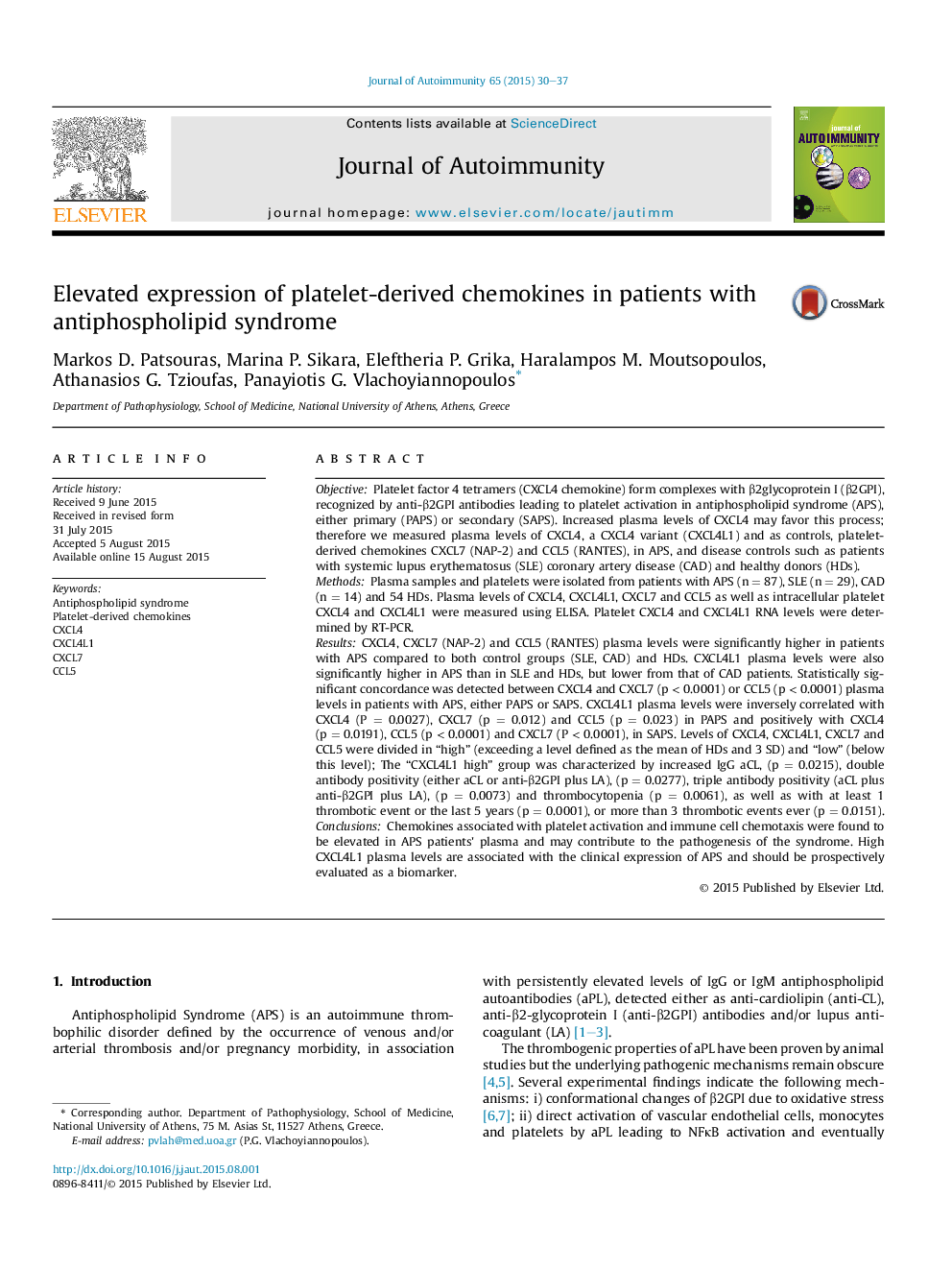| کد مقاله | کد نشریه | سال انتشار | مقاله انگلیسی | نسخه تمام متن |
|---|---|---|---|---|
| 3367695 | 1592284 | 2015 | 8 صفحه PDF | دانلود رایگان |
• Increased plasma levels of platelet derived chemokines characterize APS.
• Their increase pattern is unique for APS.
• These chemokines influence angiogenesis in many ways probably beyond thrombosis.
ObjectivePlatelet factor 4 tetramers (CXCL4 chemokine) form complexes with β2glycoprotein I (β2GPI), recognized by anti-β2GPI antibodies leading to platelet activation in antiphospholipid syndrome (APS), either primary (PAPS) or secondary (SAPS). Increased plasma levels of CXCL4 may favor this process; therefore we measured plasma levels of CXCL4, a CXCL4 variant (CXCL4L1) and as controls, platelet-derived chemokines CXCL7 (NAP-2) and CCL5 (RANTES), in APS, and disease controls such as patients with systemic lupus erythematosus (SLE) coronary artery disease (CAD) and healthy donors (HDs).MethodsPlasma samples and platelets were isolated from patients with APS (n = 87), SLE (n = 29), CAD (n = 14) and 54 HDs. Plasma levels of CXCL4, CXCL4L1, CXCL7 and CCL5 as well as intracellular platelet CXCL4 and CXCL4L1 were measured using ELISA. Platelet CXCL4 and CXCL4L1 RNA levels were determined by RT-PCR.ResultsCXCL4, CXCL7 (NAP-2) and CCL5 (RANTES) plasma levels were significantly higher in patients with APS compared to both control groups (SLE, CAD) and HDs. CXCL4L1 plasma levels were also significantly higher in APS than in SLE and HDs, but lower from that of CAD patients. Statistically significant concordance was detected between CXCL4 and CXCL7 (p < 0.0001) or CCL5 (p < 0.0001) plasma levels in patients with APS, either PAPS or SAPS. CXCL4L1 plasma levels were inversely correlated with CXCL4 (P = 0.0027), CXCL7 (p = 0.012) and CCL5 (p = 0.023) in PAPS and positively with CXCL4 (p = 0.0191), CCL5 (p < 0.0001) and CXCL7 (P < 0.0001), in SAPS. Levels of CXCL4, CXCL4L1, CXCL7 and CCL5 were divided in “high” (exceeding a level defined as the mean of HDs and 3 SD) and “low” (below this level); The “CXCL4L1 high” group was characterized by increased IgG aCL, (p = 0.0215), double antibody positivity (either aCL or anti-β2GPI plus LA), (p = 0.0277), triple antibody positivity (aCL plus anti-β2GPI plus LA), (p = 0.0073) and thrombocytopenia (p = 0.0061), as well as with at least 1 thrombotic event or the last 5 years (p = 0.0001), or more than 3 thrombotic events ever (p = 0.0151).ConclusionsChemokines associated with platelet activation and immune cell chemotaxis were found to be elevated in APS patients' plasma and may contribute to the pathogenesis of the syndrome. High CXCL4L1 plasma levels are associated with the clinical expression of APS and should be prospectively evaluated as a biomarker.
Journal: Journal of Autoimmunity - Volume 65, December 2015, Pages 30–37
